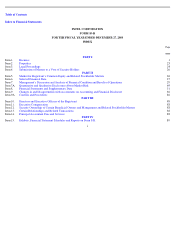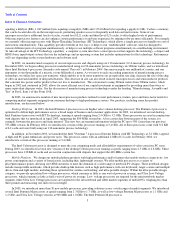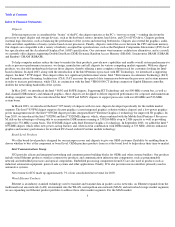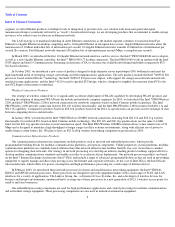Intel 2003 Annual Report Download - page 4
Download and view the complete annual report
Please find page 4 of the 2003 Intel annual report below. You can navigate through the pages in the report by either clicking on the pages listed below, or by using the keyword search tool below to find specific information within the annual report.
Table of Contents
Index to Financial Statements
PART I
Industry
We are the world’s largest semiconductor chip maker, supplying advanced technology solutions for the computing and communications
industries. Our goal is to be the preeminent building block supplier to the worldwide Internet economy. Our products include chips, boards and
other semiconductor components that are the building blocks integral to computers, servers, and networking and communications products. We
offer products at various levels of integration, allowing our customers flexibility to create advanced computing and communications systems
and products.
Intel’s component-level products consist of integrated circuits used to process information. Our integrated circuits are silicon chips,
known as semiconductors, etched with interconnected electronic switches. Developments in semiconductor design and manufacturing have
made it possible to decrease the size of circuits and transistors etched into silicon, utilizing less space as a result. This decrease in size enables
us to put increased numbers of transistors on an equivalent size chip, decrease the size of the chip or offer an increased number of integrated
features, which can result in microprocessors that are faster or incorporate additional features, products that consume less power and/or
products that cost less to manufacture.
We were incorporated in California in 1968 and reincorporated in Delaware in 1989. Our Internet address is www.intel.com . On this web
site, we publish voluntary reports, which are updated annually, outlining our performance with respect to corporate responsibility and
environmental, health and safety compliance (these voluntary reports are not incorporated by reference into this filing). On our Investor
Relations web site, located at www.intc.com , we post the following filings as soon as reasonably practicable after they are electronically filed
with or furnished to the Securities and Exchange Commission: our annual report on Form 10-K, our quarterly reports on Form 10-Q, our
current reports on Form 8-K, our proxy statement on Form 14A related to our annual stockholders’ meeting and any amendments to those
reports or statements filed or furnished pursuant to Section 13(a) or 15(d) of the Securities Exchange Act of 1934. All such filings on our
Investor Relations web site are available free of charge.
Products
Our major products include microprocessors; chipsets; boards; wired Ethernet and wireless connectivity products; communications
infrastructure components such as network and embedded processors and optical components; microcontrollers; flash memory; application and
cellular processors used in cellular handsets and handheld computing devices; and cellular baseband chipsets.
Our major customers are:
Our primary focus is on developing advanced integrated silicon technology solutions, which we believe will provide the performance and
technology features necessary to help accelerate the convergence of computing and communications capabilities. Convergence refers to having
computing and communications capabilities in an integrated product solution. We also provide key components for networking and
communications infrastructures used to connect technology users. We believe users of computing and communications devices want not only
higher performance but also other capabilities such as multithreaded or multitasking capability, seamless networking connectivity, improved
security, reliability, ease of use and interoperability among devices. It is our goal to incorporate features addressing these capabilities in our
various products to meet user demands.
Each of our operating segments uses its core competencies in the design and manufacture of integrated circuits, as well as key silicon and
platform capabilities, to provide building blocks for technology solutions. The Intel Architecture business provides the advanced technologies
to support the desktop, mobile and enterprise computing platforms. During 2003, our Intel Communications
1
ITEM 1.
BUSINESS
• original equipment manufacturers (OEMs) and original design manufacturers (ODMs) who make computer systems, cellular
handsets and handheld computing devices, and telecommunications and networking communications equipment;
• PC and network communications products users (including individuals, large and small businesses, and service providers) who buy
PC components and board-level products, as well as Intel’s networking and communications products, through distributor, reseller,
retail and OEM channels throughout the world; and
•
other manufacturers, including makers of a wide range of industrial and communications equipment.

















